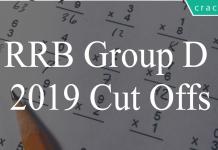Statement & Conclusion Questions for RRB NTPC
Download RRB NTPC Statement & Conclusion Questions and Answers PDF. Top 20 RRB NTPC Maths questions based on asked questions in previous exam papers very important for the Railway NTPC exam.
Download Statement & Conclusion Questions for RRB NTPC
Take a free mock test for RRB NTPC
Download RRB NTPC Previous Papers PDF
Instructions
In each of the following questions one or two statements are given, followed by two Conclusions, I and II. You have to consider the statement to be true, even if it seems to be at variance from commonly known facts. You have to decide which of the given conclusions can definitely be drawn from the given statement. Indicate your answer.
Question 1: Statements
1. Authors are learned people
2. Some doctors are authors
Conclusions
I. Some doctors are learned people
II. Some learned people are doctors.
a) Both I and II are implicit
b) Neither I nor II is implicit
c) Only I is implicit
d) Only II is implicit
Question 2: Statement
Economic security makes people better and happier and has a good influence on their personality.
Conclusions
I. People who earn enough money are happier
II.To have a good personality people should be economically sound.
a) Only I follows.
b) Both I and II follow
c) Only II follows.
d) Neither I nor II follows
Question 3: Statement is given followed by three conclusions I, II and III. You have to consider the statement to be true even they seem to be at variance from commonly known facts. You have to decide which of the given conclusions, if any, follows from the given statement.
Statement: Comic books contain pictures
Conclusions:
I. All books contain pictures
II. Books may or may not contain pictures
III. Books other than the comic books does not contain pictures.
a) Only Conclusion I follows
b) Only Conclusion II follows
c) Both Conclusions I and II follows
d) Neither Conclusion follows
RRB NTPC Previous Papers [Download PDF]
Question 4: There are two statements labelled as Assertion (A) and Reason (R).
A.A little gap is left between iron rails.
R. Iron expands is summer.
a) Both (A) and (R) are true.
b) Both (A) and (R) are false.
c) (A) is true and (R) is false.
d) (A) is false and (R) is true.
Instructions
Two statements are given followed by two Conclusions / Assumptions, I and II. You have to consider the statement to be true, even if it seems at variance from commonly known facts. You are to decide which of the given conclusions / assumptions can definitely be drawn from given statements. Indicate your answer.
Question 5: Statements
1. No teacher come to the school on a bicycle.
b: Anand comes to the school on a bicycle.
Conclusions
I. Anand is not a teacher
II. Anand is a student.
a) Conclusion II alone can be drawn.
b) Both conclusions cannot be drawn.
c) Both conclusions can be drawn.
d) Conclusion I alone can be drawn.
Instructions
In each of the following question below are given some statements followed by some conclusions. Taking the given statements to be true even if they seem to be at variance from commonly known facts, read all the conclusions and then decide which of the given conclusion logically follows the given statements.
Question 6: Statements:
I. All cups are pencils.
II. Some pencils are pens.
Conclusions:
I. Some pencils are cups.
II. No pencil are cups.
III. Some cups are pens.
a) Only conclusion (I) follows
b) Only conclusion (III) follows
c) Only conclusion (I) and (II) follow
d) Only conclusion (II) and (III) follow
Question 7: Statements:
I. All boys are smart.
II. All smart are thin.
Conclusions:
I. All boys are thin.
II. All smart are boys.
a) Only conclusion (I) follows
b) Only conclusion (II) follows
c) Both conclusion follow
d) Neither conclusion (I) nor conclusion (II) follows
Instructions
In each of the following question below are given some statements followed by some conclusions. Taking the given statements to be true even if they seem to be at variance from commonly known facts, read all the conclusions and then decide which of the given conclusion logically follows the given statements.
Question 8: Statements:
I. No cities are countries.
II. No countries are villages.
Conclusions:
I. Some countries are city.
II. No villages are city.
a) Only conclusion (I) follows
b) Only conclusion (II) follows
c) Both conclusion follow
d) Neither conclusion (I) nor conclusion (II) follows
Question 9: Statements:
I. All cups are glasses.
II. Some cups are pens.
Conclusions:
I. Some pens are cups.
II. Some pens are glasses.
III. Some pens are not cups.
a) Only conclusion (I) and (III) follow
b) Only conclusion (II) and (III) follow
c) Only conclusion (I) and (II) follow
d) All conclusions follow
Instructions
In each of the following question below are given some statements followed by some conclusions. Taking the given statements to be true even if they seem to be at variance from commonly known facts, read all the conclusions and then decide which of the given conclusion logically follows the given statements.
Question 10: I. Some pens are cups.
II. No cups are plates.
Conclusions:
I. Some pens are not plates.
II. All pens are plates.
III. Some plates are not pens.
a) Either conclusion (I) or (III) follow
b) Only conclusion (I) follows
c) Only conclusion (II) and (III) follow
d) No conclusion follows
18000+ Questions – Free SSC Study Material
Download General Science Notes PDF
Question 11: Statements:
I. Some pens are pencils.
II. All pencils are erasers.
III. Some erasers are cups.
Conclusions:
I. Some pens are cups.
II. Some pencils are cups.
III. Some cups are pencils.
IV. Some erasers are pens.
a) Only conclusion (II) follows
b) Only conclusion (IV) follows
c) Only conclusion (I) follows
d) No conclusion follows
Instructions
In each of the following question below are given some statements followed by some conclusions. Taking the given statements to be true even if they seem to be at variance from commonly known facts, read all the conclusions and then decide which of the given conclusion logically follows the given statements.
Question 12: Statements:
I. All men are hardworking.
II. No advocate is hardworking.
III. Some beautiful are men.
Conclusions:
I. Some beautiful are hardworking.
II. Some advocates are not beautiful.
III. Some beautiful are not advocate.
a) Only conclusion (I) follow
b) Only conclusion (I) and (III) follow
c) Only conclusion (II) and (III) follow
d) Only conclusion (I) and (II) follow
Question 13: Statements:
I. No cups are plate.
II. All plates are spoons.
Conclusions:
I. Some cups are not spoons.
II. Some spoons are plates.
III. Some plates are spoons.
a) Only conclusion (II) follows
b) Only conclusion (III) follows
c) Only conclusion (I) and (III) follow
d) Only conclusion (II) and (III) follow
Instructions
In each of the following question below are given some statements followed by some conclusions. Taking the given statements to be true even if they seem to be at variance from commonly known facts, read all the conclusions and then decide which of the given conclusion logically follows the given statements.
Question 14: Statements:
I. Some mangoes are not red.
II. All red are raw.
III. Some raw are mangoes.
Conclusions:
I. Some mangoes are not raw.
II. Some red are not mangoes.
III. All raw are red.
a) Only conclusion (I) follows
b) Only conclusion (II) and (III) follow
c) Only conclusion (I) and (III) follow
d) No conclusion follows
Question 15: Statements:
I. Some knifes are spoons.
II. Some forks are knifes.
III. No fork is a green.
Conclusions:
I. Some spoons are forks.
II. Some knifes are green.
III. Some green are not knifes.
IV. Some forks are not green.
a) Only conclusion (IV) follows
b) Only conclusion (III) follows
c) Only conclusion (III) and (I) follow
d) Only conclusion (I) and (II) follow
Instructions
In each of the following question below are given some statements followed by some conclusions. Taking the given statements to be true even if theyseem to be at variance from commonly known facts, read all the conclusions and then decide which of the given conclusion logically follows the given statements.
Question 16: In each of the following question below are given some statements followed by some conclusions. Taking the given statements to be true even if they seem to be at variance from commonly known facts, read all the conclusions and then decide which of the given conclusion logically follows the given statements.
Statements:
I. Some beautiful are intelligent.
II. All intelligent are daughters.
Conclusions:
I. Some intelligent are beautiful.
II. Some daughters are intelligent.
III. Some beautiful are daughters.
a) Only conclusion (I) and (II) follow
b) Only conclusion (I) and (III) follow
c) Only conclusion (II) and (III) follow
d) All conclusions follow
Question 17: Statements:
I. Some pens are glass.
II. All glass are wall.
Conclusions:
I. Some wall are pens.
II. Some wall are glass.
a) Only conclusion (I) follows
b) Only conclusion (II) follows
c) Both conclusion follow
d) Neither conclusion (I) nor conclusion (II) follows
Daily Free RRB Online Tests for RRB Exams
Question 18: Which conclusions is true with respect to the given statements ?
Statements:
(i) Roy studies History and Political Science
(ii) Roy studies in Oxford University
Conclusions:
a) Roy does not study Political Science
b) Roy studies History and Political Science in Oxford University
c) Roy studies Social Science
d) Roy does not study History
Question 19: Two statements are given, each followed by two conclusion/assumption, I and II. You have to consider the statement to be true even if they seem to be at variance from commonly known facts. You have to decide which of the given conclusion/assumptions, if any, follows from the given statements.
Statements:
(i) Some papers are pens
(ii) All the pencils are pens
Conclusions:
I. Some pens are pencils
II. Some pens are papers
a) Either I or II follows
b) Both I and II follows
c) Only I conclusions follows
d) Only II conclusion follows
Question 20: In the question one statement is given. You have to answer considering the statement to be true, even if it seem to be at variance from commonly known facts.
Statement: Students go to school in uniforms.
a) Uniforms are compulsory
b) Students look smart in uniforms
c) Uniforms are easily
d) Uniforms create a sense of belongingness
Download Current Affairs Questions & Answers PDF
Answers & Solutions:
1) Answer (A)
The venn diagram for above statements is :

Conclusions
I. Some doctors are learned people = true
II. Some learned people are doctors = true
Thus, both I and II are implicit.
=> Ans – (A)
2) Answer (A)
The above statement indicates that having economic security, meaning those who earn more money are happier and it also has a good influence on their personality, but vice-versa is not true, hence second conclusion does not follow.
Thus, only conclusion I follows.
=> Ans – (A)
3) Answer (B)
4) Answer (A)
5) Answer (D)
The given statement indicates that none of the teachers of a school uses bicycle to come to the school and Anand comes to school using a bicycle, thus this concludes that Anand is not a teacher, but we cannot know whether Anand is a student or not.
Thus, conclusion I alone can be drawn.
=> Ans – (D)
6) Answer (A)
The venn diagram for above statements is :
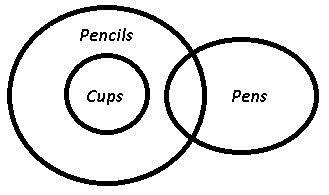
Conclusions:
I. Some pencils are cups = true
II. No pencil are cups = false
III. Some cups are pens = false
Thus, only conclusion (I) follows.
=> Ans – (A)
7) Answer (A)
The venn diagram for above statements is :
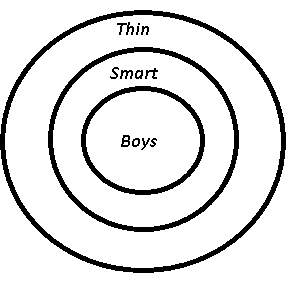
Conclusions:
I. All boys are thin = true
II. All smart are boys = false
Thus, only conclusion (I) follows.
=> Ans – (A)
8) Answer (D)
The venn diagram for above statements is :
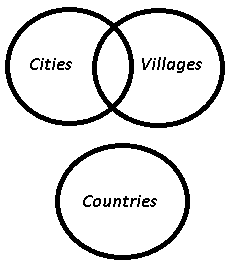
Conclusions:
I. Some countries are city = false
II. No villages are city = false
Thus, neither conclusion (I) nor conclusion (II) follows.
=> Ans – (D)
9) Answer (C)
The venn diagram for above statements is :
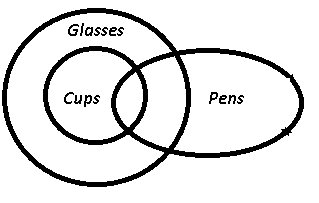
Conclusions:
I. Some pens are cups = true
II. Some pens are glasses = true
III. Some pens are not cups = false
Thus, only conclusion (I) and (II) follow.
=> Ans – (C)
10) Answer (A)
The venn diagram for above statements is :
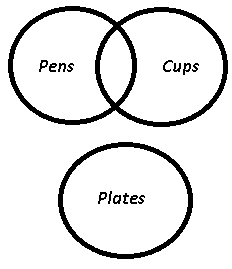
Conclusions:
I. Some pens are not plates = may or may not be true
II. All pens are plates = false
III. Some plates are pens = may or may not be true
Thus, either conclusion (I) or (III) follow.
=> Ans – (A)
11) Answer (B)
The venn diagram for above statements is :
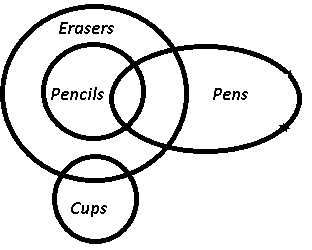
Conclusions:
I. Some pens are cups = false
II. Some pencils are cups = false
III. Some cups are pencils = false
IV. Some erasers are pens = true
Thus, only conclusion (IV) follows.
=> Ans – (B)
12) Answer (A)
The venn diagram for above statements is :
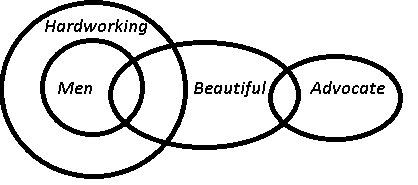
Conclusions:
I. Some beautiful are hardworking = true
II. Some advocates are not beautiful = may or may not be true
III. Some beautiful are not advocate = may or may not be true
Thus, only conclusion (I) follows.
=> Ans – (A)
13) Answer (D)
The venn diagram for above statements is :

Conclusions:
I. Some cups are not spoons = falsse
II. Some spoons are plates = true
III. Some plates are spoons = true
Thus, only conclusion (II) and (III) follow.
=> Ans – (D)
14) Answer (D)
The venn diagram for above statements is :
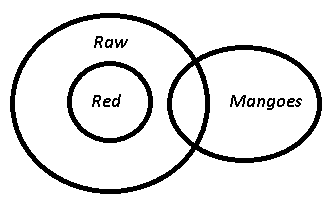
Conclusions:
I. Some mangoes are not raw = false
II. Some red are not mangoes = true
III. All raw are red = false
Thus, no conclusion follows.
=> Ans – (D)
15) Answer (A)
The venn diagram for above statements is :
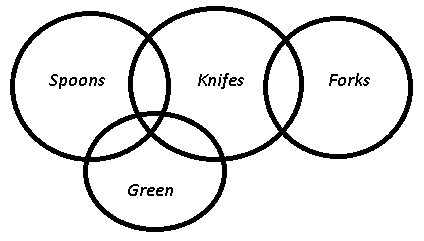
Conclusions:
I. Some spoons are forks = false
II. Some knifes are green = may or may not be true
III. Some green are not knifes = may or may not be true
IV. Some forks are not green = true
Thus, only conclusion (IV) follows.
=> Ans – (A)
16) Answer (D)
The venn diagram for above statements is :
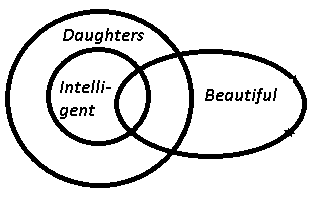
Conclusions:
I. Some intelligent are beautiful = true
II. Some daughters are intelligent = true
III. Some beautiful are daughters = true
Thus, all conclusions follow.
=> Ans – (D)
17) Answer (C)
The venn diagram for above statements is :
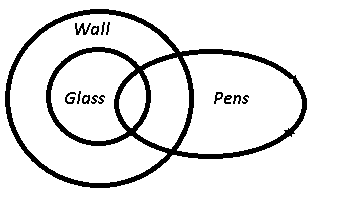
Conclusions:
I. Some wall are pens = true
II. Some wall are glass = true
Thus, both conclusion follow.
=> Ans – (C)
18) Answer (B)
The statements indicates that Roy studies in Oxford University and he studies History and Political Science.
Thus, the first and last options are eliminated as they conclude completely opposite thing.
=> Ans – (B)
19) Answer (B)
The venn diagram for above statements is :
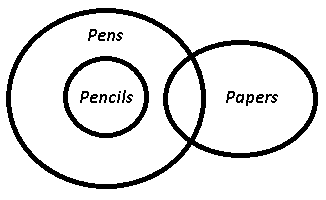
Conclusions:
I. Some pens are pencils = true
II. Some pens are papers = true
Thus, both I and II follows.
=> Ans – (B)
20) Answer (E)
DOWNLOAD APP FOR RRB FREE MOCKS
We hope this Statement & Conclusion for RRB NTPC Exam will be highly useful for your preparation.





